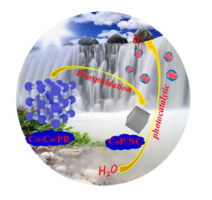Journal of Catalysis ( IF 6.5 ) Pub Date : 2019-12-23 , DOI: 10.1016/j.jcat.2019.12.009 Yinjuan Dong , Tian Tian , Chunjiang Xu , Kangwei Ma , Wanjun Sun , Yong Ding

|
Designing and developing an efficient, economic and stable catalyst for photocatalytic water oxidation is a forefront topic of sustainable energy research. Herein, we rationally designed a CoP/NC (CoP nanoparticles embedded in nitrogen and carbon matrices) nanocube catalysts via a pyrolysis phosphidation strategy derived from Co-Co/PB (Co-Co prussian blue) MOF-based precursor, which was employed as a robust heterogeneous catalyst for photocatalytic water oxidation for the first time. The TEM and SEM tests exhibit that Co-Co/PB contributes to well-defined nanocube architecture features after phosphidation. Furthermore, the photocatalytic performance of CoP/NC nanocube catalyst was examined in photocatalytic water oxidation system using [Ru(bpy)3]2+ as photosensitizer and S2O82− as sacrificial electron acceptor. The result shows CoP/NC has a modest high O2 evolution rate of 901.5 mmol h−1 g−1, O2 yield of 36.1%, TOF of 34.5 × 10−3 molO2 molmetal−1 s−1, and quantum yield of 61.5%. Noteworthily, an amorphous CoOx layer on CoP/NC surface was observed by HRTEM test after light reaction. The amorphous CoOx layer and CoP form a core-shell structure ([email protected]x), which facilitates the electron transport effectively. Additionally, the CoP/NC nanocube catalyst shows good electrocatalytic oxygen evolution performance, which has a higher current density and smaller Tafel slope than CoS2/NC and Co3O4/NC derived from the same precursor of Co-Co/PB with CoP/NC. This strategy of using prussian blue analogue as template to create metal phosphide will provide a platform for exploring highly efficient and stable catalysts for energy conversion reactions.
中文翻译:

立方钴钴普鲁士蓝MOF基过渡金属磷化物可作为可见光驱动水氧化的有效催化剂
设计和开发一种高效,经济,稳定的光催化水氧化催化剂是可持续能源研究的首要课题。在这里,我们通过基于Co-Co / PB(普鲁士蓝)的前驱体的热解磷化策略,合理设计了CoP / NC(嵌入氮和碳基质中的CoP纳米颗粒)纳米立方催化剂。首次用于光催化水氧化的强力多相催化剂。TEM和SEM测试表明,磷化后Co-Co / PB有助于明确定义的纳米立方体结构特征。此外,使用[Ru(bpy)3 ] 2+在光催化水氧化系统中研究了CoP / NC纳米立方催化剂的光催化性能。作为光敏剂,S 2 O 8 2-为牺牲电子受体。结果表明,CoP / NC具有适度的高O 2释放速率901.5 mmol h -1 g -1,O 2产率为36.1%,TOF为34.5×10 -3 mol O2 mol金属-1 s -1和量子产率61.5%。值得注意的是,光反应后,通过HRTEM测试观察到CoP / NC表面有无定形的CoO x层。非晶态CoO x层和CoP形成核-壳结构([电子邮件保护] x),从而有效地促进了电子的传输。此外,CoP / NC纳米立方体催化剂显示出良好的电催化氧释放性能,与从Co-Co / PB和CoP的相同前体衍生出的CoS 2 / NC和Co 3 O 4 / NC相比,具有更高的电流密度和更小的塔菲尔斜率。/ NC。使用普鲁士蓝类似物作为模板来生成金属磷化物的这种策略将为探索用于能量转化反应的高效,稳定的催化剂提供一个平台。











































 京公网安备 11010802027423号
京公网安备 11010802027423号